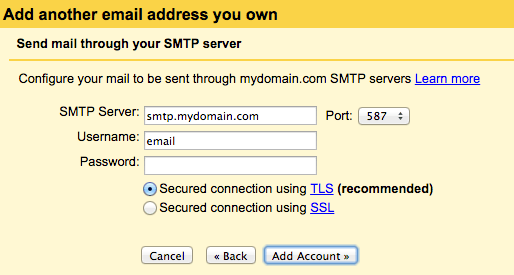9
3
I went to add an alias to a forwarded address (managed by GoDaddy, ie myemail@mydomain.com) in Gmail, and I noticed that Google changed their system. In the past, after you entered the name and email address, you'd get a screen like this:

However, now they seem to be requiring SMTP information:

I did some research and contacted GoDaddy, but it seems that you have to register an actual email address, not a forward in order to add it as an alias in Gmail.
It should be noted that all aliases to forward addresses that I'd previously set up work fine, I just can't edit them or add new ones.
Does anyone know of a workaround for this or why this would have changed? Thanks!
5
This doesn't work anymore - There is no "App Passwords Settings". Try this link http://www.tjkelly.com/blog/gmail-godaddy-email-forwarding/ which is a more recent blog on how to. Good Luck.
– Akash – 2016-01-07T08:04:34.003@AakashShah worked for me! – rebello95 – 2016-01-27T05:25:43.477
@rebello95 thats good. Are you already with 2-factor-authentication on your google account? – Akash – 2016-01-27T09:23:13.253
@AakashShah yep I am – rebello95 – 2016-01-27T13:11:59.467
@rebello95 that's that explains why it worked for you then. cool. – Akash – 2016-01-28T08:47:56.310
1@AakashShah yeah you have to have it enabled in order to use app specific passwords. Otherwise it doesn't work – rebello95 – 2016-01-28T11:56:53.560
I believe this change to Gmail had to do with Google's stance/preference for sending digitally-signed emails, as a means of major email providers trying to reduce email based spam. -- since SMTP is not secure as a protocol, there is no integrated provision for authenticating the transmitting server. This has been solved by an agreement to include headers with such information. However, since Google cannot legitimately sign a message with e.g. Microsoft's signing certificate, any mail sent by Google as a Microsoft (live, msn, outlook, etc) address will have mismatched info and look suspicious – Code Jockey – 2016-02-04T19:41:16.933
if I ever get enough rep to answer a protected question on here, I'll come back and give it a full treatment, but this article from Google has a bit more info about it: http://googlesystem.blogspot.com/2014/08/external-addresses-no-longer-use-gmail.html
– Code Jockey – 2016-02-04T19:42:36.263Here in 2019, the Ellis Benus method still works (Even though the Google documentation on this is stuck at 2014... Sheesh...) Nice! And THANKS! BTW - Didn't work for me the 1st time with a weird 'can't load Gmail' error at the final step of the pop-up form (99% sure I did everything right), but worked fine on 2nd try. Persistence pays off! – spechter – 2019-05-29T13:19:04.327